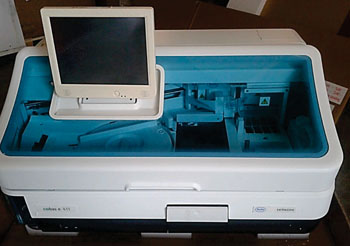Prognostic Biomarkers Predict Dengue Shock and Organ Failure
|
By LabMedica International staff writers Posted on 07 Sep 2016 |

Image: The Cobas e 411 immunoassay analyzer (Photo courtesy of Roche Diagnostics).
There are presently no biomarkers that can predict the incidence of dengue shock and/or organ failure, although the early identification of risk factors is important in determining appropriate management to reduce mortality.
Mortality rates among patients who have been hospitalized with severe dengue are 1.6% to 10.9%, and death in adults is mainly due to the development of dengue shock and organ dysfunction. The prognostic value of serum procalcitonin (PCT) and peripheral venous lactate (PVL) levels as biomarkers of dengue shock and/or organ failure have been evaluated.
Scientists at Mahidol University (Bangkok, Thailand) conducted a prospective observational study among adults hospitalized for confirmed viral dengue infection between October 2013 and July 2015. Of 160 patients with dengue, 128 (80.0%) patients had dengue without shock or organ failure, whereas 32 (20.0%) patients developed dengue with shock and/or organ failure. Laboratory tests were conducted at admission, including a complete blood count and blood chemistry assessment, and samples for the measurement of PCT and PVL were collected.
PCT was measured using an electrochemiluminescence method (Elecsys BRAHMS PCT, Roche Diagnostic, Mannheim, Germany) using a Roche Diagnostic Cobas e 411 immunoassay analyzer. The detection limit for the PCT assay was 0.02 ng/mL. PVL levels were measured by a colorimetric assay with an enzymatic reaction using a Cobas C Systems autoanalyzer (Roche/Hitachi, Indianapolis, IN, USA). All sera collected at admission and two weeks after admission were tested using four separate capture enzyme-linked immunosorbent assays (ELISA) for immunoglobulin M (IgM) and IgG against dengue virus and Japanese encephalitis virus.
The team found that patients with dengue shock and/or organ failure had significantly higher PCT levels and higher PVL levels, higher hemoglobin concentrations, increased hematocrit values above baseline, elevated while blood counts (WBC), higher absolute bands, increased atypical lymphocyte counts, higher alanine aminotransferase (ALT) and aspartate aminotransferase (AST) levels. However, patients with dengue shock and/or organ failure had significantly lower platelet counts and albumin levels. Dengue shock patients with non-clearance of PCT and PVL expired during hospitalization.
The authors concluded that a PCT equal to or greater than 0.7 ng/mL and a PVL equal to or greater than 2.5 mmol/L were independently associated with dengue shock and/or organ failure. The combination of PCT and PVL levels could be used as prognostic biomarkers for the prediction of dengue shock and/or organ failure. The study was published on August 26, 2016, in the journal Public Library of Science Neglected Tropical Diseases.
Related Links:
Mahidol University
Roche Diagnostic
Roche/Hitachi
Mortality rates among patients who have been hospitalized with severe dengue are 1.6% to 10.9%, and death in adults is mainly due to the development of dengue shock and organ dysfunction. The prognostic value of serum procalcitonin (PCT) and peripheral venous lactate (PVL) levels as biomarkers of dengue shock and/or organ failure have been evaluated.
Scientists at Mahidol University (Bangkok, Thailand) conducted a prospective observational study among adults hospitalized for confirmed viral dengue infection between October 2013 and July 2015. Of 160 patients with dengue, 128 (80.0%) patients had dengue without shock or organ failure, whereas 32 (20.0%) patients developed dengue with shock and/or organ failure. Laboratory tests were conducted at admission, including a complete blood count and blood chemistry assessment, and samples for the measurement of PCT and PVL were collected.
PCT was measured using an electrochemiluminescence method (Elecsys BRAHMS PCT, Roche Diagnostic, Mannheim, Germany) using a Roche Diagnostic Cobas e 411 immunoassay analyzer. The detection limit for the PCT assay was 0.02 ng/mL. PVL levels were measured by a colorimetric assay with an enzymatic reaction using a Cobas C Systems autoanalyzer (Roche/Hitachi, Indianapolis, IN, USA). All sera collected at admission and two weeks after admission were tested using four separate capture enzyme-linked immunosorbent assays (ELISA) for immunoglobulin M (IgM) and IgG against dengue virus and Japanese encephalitis virus.
The team found that patients with dengue shock and/or organ failure had significantly higher PCT levels and higher PVL levels, higher hemoglobin concentrations, increased hematocrit values above baseline, elevated while blood counts (WBC), higher absolute bands, increased atypical lymphocyte counts, higher alanine aminotransferase (ALT) and aspartate aminotransferase (AST) levels. However, patients with dengue shock and/or organ failure had significantly lower platelet counts and albumin levels. Dengue shock patients with non-clearance of PCT and PVL expired during hospitalization.
The authors concluded that a PCT equal to or greater than 0.7 ng/mL and a PVL equal to or greater than 2.5 mmol/L were independently associated with dengue shock and/or organ failure. The combination of PCT and PVL levels could be used as prognostic biomarkers for the prediction of dengue shock and/or organ failure. The study was published on August 26, 2016, in the journal Public Library of Science Neglected Tropical Diseases.
Related Links:
Mahidol University
Roche Diagnostic
Roche/Hitachi
Latest Microbiology News
- Blood-Based Molecular Signatures to Enable Rapid EPTB Diagnosis
- 15-Minute Blood Test Diagnoses Life-Threatening Infections in Children
- High-Throughput Enteric Panels Detect Multiple GI Bacterial Infections from Single Stool Swab Sample
- Fast Noninvasive Bedside Test Uses Sugar Fingerprint to Detect Fungal Infections
- Rapid Sepsis Diagnostic Device to Enable Personalized Critical Care for ICU Patients
- Microfluidic Platform Assesses Neutrophil Function in Sepsis Patients
- New Diagnostic Method Confirms Sepsis Infections Earlier
- New Markers Could Predict Risk of Severe Chlamydia Infection
- Portable Spectroscopy Rapidly and Noninvasively Detects Bacterial Species in Vaginal Fluid
- CRISPR-Based Saliva Test Detects Tuberculosis Directly from Sputum
- Urine-Based Assay Diagnoses Common Lung Infection in Immunocompromised People
- Saliva Test Detects Implant-Related Microbial Risks
- New Platform Leverages AI and Quantum Computing to Predict Salmonella Antimicrobial Resistance
- Early Detection of Gut Microbiota Metabolite Linked to Atherosclerosis Could Revolutionize Diagnosis
- Viral Load Tests Can Help Predict Mpox Severity
- Gut Microbiota Analysis Enables Early and Non-Invasive Detection of Gestational Diabetes
Channels
Clinical Chemistry
view channel
Chemical Imaging Probe Could Track and Treat Prostate Cancer
Prostate cancer remains a leading cause of illness and death among men, with many patients eventually developing resistance to standard hormone-blocking therapies. These drugs often lose effectiveness... Read more
Mismatch Between Two Common Kidney Function Tests Indicates Serious Health Problems
Creatinine has long been the standard for measuring kidney filtration, while cystatin C — a protein produced by all human cells — has been recommended as a complementary marker because it is influenced... Read moreMolecular Diagnostics
view channel
Urine Test Detects Inherited Neuropathy Missed by Genetic Screening
Sorbitol dehydrogenase (SORD)-related neuropathy is one of the most common inherited nerve disorders, yet diagnosis often lags because current genetic screens frequently miss the causal gene.... Read more
Genomic Test Predicts Risk of SCC Metastasis
Managing squamous cell carcinoma (SCC) of the skin in patients with one or more risk factors is a significant clinical challenge, especially as SCC-related deaths are now estimated to exceed those from melanoma.... Read moreHematology
view channel
Platelet Activity Blood Test in Middle Age Could Identify Early Alzheimer’s Risk
Early detection of Alzheimer’s disease remains one of the biggest unmet needs in neurology, particularly because the biological changes underlying the disorder begin decades before memory symptoms appear.... Read more
Microvesicles Measurement Could Detect Vascular Injury in Sickle Cell Disease Patients
Assessing disease severity in sickle cell disease (SCD) remains challenging, especially when trying to predict hemolysis, vascular injury, and risk of complications such as vaso-occlusive crises.... Read more
ADLM’s New Coagulation Testing Guidance to Improve Care for Patients on Blood Thinners
Direct oral anticoagulants (DOACs) are one of the most common types of blood thinners. Patients take them to prevent a host of complications that could arise from blood clotting, including stroke, deep... Read moreImmunology
view channel
Chip Captures Cancer Cells from Blood to Help Select Right Breast Cancer Treatment
Ductal carcinoma in situ (DCIS) accounts for about a quarter of all breast cancer cases and generally carries a good prognosis. This non-invasive form of the disease may or may not become life-threatening.... Read more
Blood-Based Liquid Biopsy Model Analyzes Immunotherapy Effectiveness
Immunotherapy has revolutionized cancer care by harnessing the immune system to fight tumors, yet predicting who will benefit remains a major challenge. Many patients undergo costly and taxing treatment... Read morePathology
view channel
Blood Test and Sputum Analysis Predict Acute COPD Exacerbation
Chronic obstructive pulmonary disease (COPD) remains a major contributor to global illness, largely driven by cigarette smoking and marked by irreversible lung damage. Acute exacerbations can accelerate... Read more
AI Tool to Transform Skin Cancer Detection with Near-Perfect Accuracy
Melanoma continues to be one of the most difficult skin cancers to diagnose because it often resembles harmless moles or benign lesions. Traditional AI tools depend heavily on dermoscopic images alone,... Read more
Unique Immune Signatures Distinguish Rare Autoimmune Condition from Multiple Sclerosis
Myelin oligodendrocyte glycoprotein antibody–associated disease (MOGAD) is a rare autoimmune disorder in which the immune system attacks the myelin sheath in the central nervous system. Although symptoms... Read moreTechnology
view channel
AI Saliva Sensor Enables Early Detection of Head and Neck Cancer
Early detection of head and neck cancer remains difficult because the disease produces few or no symptoms in its earliest stages, and lesions often lie deep within the head or neck, where biopsy or endoscopy... Read more
AI-Powered Biosensor Technology to Enable Breath Test for Lung Cancer Detection
Detecting lung cancer early remains one of the biggest challenges in oncology, largely because current tools are invasive, expensive, or unable to identify the disease in its earliest phases.... Read moreIndustry
view channel
Abbott Acquires Cancer-Screening Company Exact Sciences
Abbott (Abbott Park, IL, USA) has entered into a definitive agreement to acquire Exact Sciences (Madison, WI, USA), enabling it to enter and lead in fast-growing cancer diagnostics segments.... Read more
























